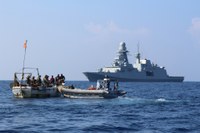Indian Ocean 2018: Threat Update and Recommendations
January 2018: For those cruisers heading from SE Asia back to the Mediterranean, winds turn favorable for a passage up the Red Sea at the end of February early March. EOS Risk Group’s Yacht Division has put together a useful article on the current threat to small boats and safety and route recommendations. For those cruisers heading from SE Asia back to the Mediterranean, winds turn favorable for a passage up the Red Sea at the end of February early March. EOS Risk Group’s Yacht Division has put together a useful article on the current threat to small boats and safety and route recommendations.
Published 8 years ago, updated 6 years ago


Following an industry revision in December 2015, the Indian Ocean piracy High-Risk Area (HRA) currently encompasses the following area:
Red Sea: 15N | Gulf of Oman: 22N | Eastern Limit: 065E | Southern Limit: 5S
The HRA and the UKMTO Voluntary Reporting Area (VRA) are displayed on the recently updated maritime security chart Q6099, which can be downloaded from the UK Hydrographic website (Admiralty) It is recommended that all cruisers have a copy of this chart before undertaking any Indian Ocean voyages.
The revision of the boundaries of the HRA followed a continued flatlining of Somali piracy activity post-2013, indicative of the success of international naval patrols, widespread use of embarked armed security and protective measures outlined in Best Management Practices version 4 (BMP-4). However, since October 2016, there has been a resurgence of Somali pirate activity in the Gulf of Aden and off the eastern Somali coastline. As many as eight Somali Pirate Action Groups (PAGs) were believed to be active in northern Puntland and around the coastal towns of Hobyo and Ceel Hur in northeast Somalia in 2017.
Last year, over ten dhows and merchant’s vessels were attacked in the Gulf of Aden and at varying ranges off the eastern Somali coastline, some of which were successfully boarded and hijacked:
- On 13 March 2017, the Sri-Lanka flagged tanker MT Aris 13 was hijacked 10nm off Ras Asir, Socotra Gap, and held in Caluula, Puntland. The vessel was released on 16 March following successful clan mediation.
- On 24 March 2017, the fishing dhow Casayr II No.30 was hijacked off Eyl, Puntland. On 26 March, UKMTO reported that the show was sighted some 70nm off Qalansyia, Socotra Island. The show was reportedly released by the pirates who retained one skiff, supplies and fuel before leaving.
- On 31 March 2017, dhow Al Kausar was hijacked off Hobyo, Somalia.
- On 2 April 2017, the dhow Salama 1 was hijacked off Ceel Huur, Somalia.
- On 9 April 2017, the bulk carrier MV OS 35 was attacked and boarded by Somali pirates in the Gulf of Aden. A citadel retreat and naval response prevented a hijacking.
- On 15 April 2017, the MT Al Heera was fired upon by suspected pirates in the Gulf of Aden.
- On 22 April 2017, six Somali pirates chased and fired upon a Sierra Leone-flagged product tanker MT Costina 30nm NNE of Hobyo, Somalia. One crewmember sustained an injury while firing a flare. Pirates were unable to board.
- On 16 May 2017, the bulk carrier MV Lord Mountbatten reported being approached by Somali pirates in the Gulf of Aden. Naval assets responded, boarded dhows and confiscated one PK-type machinegun and several rounds of ammunition. Piracy unconfirmed.
- On 22 May 2017, an unidentified Iranian dhow was hijacked off northern Puntland. It was reportedly converted for use as a mothership.
- On 24 October 2017, an Iranian-flagged dhow, Sameer, was attacked 41nm SE of Socotra Island. One crew was killed and three were injured. The vessel was not hijacked
- On 18 November, an SH-90 helicopter from the Italian Navy’s ITS Virginio Fasan located a Somali Pirate Action Group (PAG) that had attempted to hijack two vessels almost 300nm SE of Mogadishu: The Panama-flagged container ship Ever Dynamic and the Spain-flagged fishing vessel Galerna III. The PAG had fired at least two RPG rounds at the Ever Dynamic, but no major damage or injuries were sustained. The Italian Navy handed over the suspects to appropriate authorities in Seychelles for prosecution.
Whilst the above incidents affected merchant vessels or dhows, small yachts present highly attractive targets to Somali pirate gangs due to their slow speed, low freeboard, and an assumption – rightly or wrongly – that they will be carrying affluent crew. The lack of attacks affecting yachts in the last few years is a product of the lack of sailing yachts operating within the HRA, and should not be interpreted by cruisers as an indication that these waters are safe. To the contrary, small yachts are extremely vulnerable to pirate groups.
Some cruisers advocate sailing in large convoys to deter potential piracy attacks. Commenting on this practice in 2011, the International Sailing Federation (ISAF) stated: “While recognizing that to be part of such a group may give a feeling of heightened security, the military does not believe that a large convoy does provide any deterrent effect”. Further recommendations for risk mitigation can be found at the end of this article.
Southern Red Sea – Yemen’s Civil War
The civil war in Yemen has led to increased insecurity in the country’s proximal waters, particularly in the southern Red Sea and Bab el Mandeb Strait. A coalition of Arab nations, led by Saudi Arabia, is currently intervening in Yemen’s civil war to oust the Al Houthi movement from territory once controlled by the internationally recognized government of Yemen. A naval interdiction operation has been enforced for vessels calling at Yemen and there has been a build-up of naval assets in the Red Sea and Gulf of Aden, many of which are engaged in live military operations. All vessels are now facing additional security risks in these waters.
The Houthi movement has been responsible for attacks on Saudi coalition and US naval assets in the Red Sea, including at least five independent anti-ship ballistic missile launches in late 2016 and 2017 (two of which were successful) and a handful of unmanned explosive-laden boat attacks (one of which heavily damaged a Saudi Al Madinah class frigate in January 2017). An unmanned explosive-laden boat attack on Jizan port, KSA, was foiled in April 2017 and several similar attacks have been conducted against Saudi-coalition vessels near the Yemeni port of Mokha.
Vessels continue to sporadically report suspicious and/or aggressive approaches in the area. On 7 December 2017, UKMTO reported that “a sailing yacht was attacked 20 km south-west of the Yemeni port of Hodeidah. Subsequent inquiries revealed that one of a group of three catamarans on route to Seychelles had experienced damage to its mainsail and decided to effect repairs in the Yemeni port city of Hodeidah. After the group left the port area they were approached by two skiffs with armed personnel on-board who fired shots at one of the catamarans. The yacht’s embarked AST exchanged shots with the skiffs, which then withdrew. The crew was unharmed and the vessels continued their passage. It is thought that this incident is unlikely to be piracy related and most likely linked to the Yemen conflict…” (Source: UKMTO).
Similar incidents of yachts being fired upon near the Hanish Islands have been reported in the past and a wide berth is advised. In March 2016, the UK-flagged sailing yacht Milashka was caught in a storm and sought refuge at Hanish al Kabir. At some point during the evening, the yacht was fired upon from the shore. A large number of bullets hit the yacht, but no injuries were reported and no vital equipment was damaged.
The Houthis have laid sea mines in the vicinity of Yemen’s Mokha port, Midi port and in the waters east of Zuqar Island. The mines are rudimentary and have contact detonators, but pose a serious threat to all vessels if not traced and dismantled. On 7 March 2017, a fishing vessel hit a mine off Midi port and three days later a Yemeni coast guard vessel hit a mine and was destroyed off Mokha. 10 people were killed across both incidents. In July 2017, Arabic media sources reported that the Houthis had laid further Iranian-built sea mines off the port of Hodeidah. On 10 July 2017, the Saudi coalition dismantled several sea mines off Midi and in September 2017, five Houthis were killed onboard a vessel while attempting to plant further mines in the area. Most recently, on 5 December 2017, a possible naval mine was found washed ashore 25nm north of Hodeidah (Ras Isa Peninsula).
Saudi Coalition aircraft and naval vessels are also engaged in military operations off the coast of Yemen and are attempting to prevent the Houthis from smuggling weapons into the country. Several shows and cargo vessels suspected to be engaged in smuggling have been destroyed by Saudi aircraft in the Red Sea. No vessel is currently allowed within Yemeni territorial waters without prior consent from the Saudi coalition and Yemeni Ministry of Transport.
Recommendations
The below guidance is in no way directive and should not be considered exhaustive. The use of the MSTC, BMP4, armed security, shifting transit times, or any other defensive measures remain the sole decision of the cruiser. Up-to-date information and advice should be sought from UKMTO, MSCHoA and World Sailing (formerly ISAF) prior to confirming voyage plans.
- ISAF/MSCHOA Yachting Guidance: “In view of the recent escalation in piratical attacks in the area of the Southern Red Sea, Gulf of Aden and the Indian Ocean, and the consequent very high risk, the essential advice is not to enter this area. However, a yacht which, despite this advice, decides on such a passage is recommended to make contact in advance with the naval authorities and to send the ISAF Warning Notice. The Warning Notice is a joint production of MSCHOA and ISAF under the auspices of the ISAF International Regulations Commission…If you are due to travel the area of high threat, please inform MSCHOA by emailing postmaster@mschoa.org, with the subject line ‘Yacht Vessel Movement’.”
- When planning to operate in the HRA/VRA, send an ‘Initial Report’ to UKMTO at least two weeks prior to entering the VRA, provide daily position updates at 0800 UTC and issue a ‘Final Report’ when exiting the HRA/VRA. Copies of these reports can be found HERE.
- The Maritime Security Centre – Horn of Africa (MSCHOA) is the planning and coordination center for EU Naval forces (EUNAVFOR). MSCHOA encourages vessels to register their movements prior to entering the High-Risk Area (including the Internationally Recommended Transit Corridor ‘IRTC’) via their website.
- Ensure adequate insurance cover is in place (such as kidnap and ransom ‘K&R’).
- Carry a UK Admiralty security chart – Q6099.
- Ensure all communications (satellite phones and VHF radios) are always fully charged with spare batteries.
- Larger yachts may wish to consider contracting professional 3-4 man embarked armed security teams for all transits within the boundaries of the HRA. This may not be feasible for smaller sailing yachts.
- Cruisers should familiarise themselves with Best Management Practices (BMP-4). BMP-4 provides advice to help merchant’s vessels avoid, deter or delay piracy attacks in the High-Risk Area, including guidance on defensive measures such as razor wire, citadels, and security-related procedures. Unfortunately, it is not possible to implement most BMP-4 style physical security measures on yachts, but it will help cruisers understand their vessel’s inherent vulnerabilities.
- Yachts transiting the Gulf of Aden and Bab el Mandeb (BEM) are advised to be aware of the Maritime Security Transit Corridor (MSTC). The purpose of this corridor is to provide a recommended merchant traffic route around which Naval Forces can focus their presence and surveillance efforts. The MTSC is comprised of:
- The Internationally Recommended Transit Corridor (IRTC) in the Gulf of Aden. Vessels can join naval convoys in the IRTC. Timings are available at MSCHOA.
- The BeM Traffic Separation Scheme (TSS) and the TSS West of the Hanish Islands.
- A two-way route directly connecting the IRTC and the BAM TSS.
- Images of the MSTC are available HERE.
UKMTO has previously advised yachts using the Gulf of Aden to sail either in the 2-mile buffer zone between the two lanes of the IRTC or on the outer limit of the appropriate lane. Yachts sailing the Gulf of Aden are advised to be carrying enough fuel to sail or motor-sail at maximum speed along the IRTC.
- Maintain a minimum 300nm from the eastern Somali coastline (for small sailing yachts, depending on vulnerability, this will likely need to be extended) and avoid sailing through the Socotra Gap.
- In the Red Sea, maintain a sensible lee from the Hanish Islands, Zuqar Island and eastern coastline of mainland Yemen as armed groups from Yemen are active in the area. Avoid sailing into Yemen’s territorial waters where possible.
- In the event of a suspected pirate attack in the Indian Ocean, issue a distress call (Mayday) over VHF Channel 16, telephone UKMTO on +971 5055 23215 or +442392222060. Follow up any call with a UKMTO After Action Report.
- In the event of any unusual activities or hostile action believed to have emanated from Yemen, report to coalition naval forces using VHF Channel 16, via e-mail at cusnc.bwc@me.navy.mil or by phone 011-973- 1785-3879 and remain in contact with the United Kingdom Maritime Trade Operations (UKMTO) (Email: UKMTO@eim.ae Emergency Tel: +971 5055 23215 Tel: +442392222060) to the maximum extent possible.
About EOS Risk Group – Yacht Division
EOS provide a full spectrum of integrated security services for the yacht and super yacht sectors, including armed and unarmed security, escort vessels, risk assessments, intelligence alerts, tracking, competent authority, training, vessel anti-piracy ‘hardening’ and marine kidnap/hijack response. EOS maritime security and crisis response services are certified by LRQA in the UK against ISO 9001, ISO 28000 and ISO 28007. Since EOS entered the maritime security market in 2006, they have ensured the safety of thousands of transits and projects across the Indian Ocean, West Africa, Southeast Asia, South America and the Mediterranean, placing a strong emphasis on compliance, intelligence, and professionalism.
Telephone (24/7): +44 1782 283 323 or +44 2037 534 630
Email: info@eosrisk.com or intelligence@eosrisk.com
Website: www.eosrisk.com
Related to following destinations: Aden, Djibouti, Egypt, Eritrea, Hodeidah, Mediterranean Coast (Egypt), Red Sea (Egypt), Saudi Arabia, Socotra, Somalia, Yemen
Related to the following Cruising Resources: Gulf of Aden / Indian Ocean / Red Sea, Indian Ocean, Piracy & Security, Red Sea, Routing




